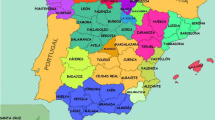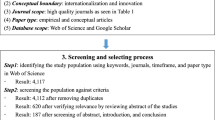Abstract
In the contemporary world economy, understood as a set of mutual connections and interdependencies, innovations are crucial for economic growth and competitiveness. Internationalization and globalization processes in the world economy also concern the innovativeness of economies, and are visible in international use of technologies developed within national innovation systems,globalization of the creation and implementation of innovations, international (global) cooperation in research and development and innovation activities, international (global) protection of intellectual property. The interdependencies between countries in terms of their innovative activity are gradually deepening. This overlaps with the links and interdependencies that exist between the national innovation system of a given country and regional, metropolitan and industry systems.
The purpose of this study is to analyze the existing links and interdependencies between the national innovation systems of various countries and to determine their impact on international competitiveness. The research focuses on national innovation systems and their international linkages, knowledge resources and international competitiveness. It proposes a conceptual approach to characterize and study the interdependencies indicated above. With reference to theoretical approaches, it shapes a framework that could be the basis for further empirical analyses.
Access this chapter
Tax calculation will be finalised at checkout
Purchases are for personal use only
Similar content being viewed by others
Notes
- 1.
Ultimately, due to lack of data, the sample amounted to 23 countries (cf. [30]).
References
Romer, P.: Endogenous technological change. J. Polit. Econ. 98, 71–102 (1990)
Aghion, P., Howitt, P.: The Economics of Growth. MIT Press, Cambridge MA, London (2009)
Porter, M.: The Competitive Advantage of Nations. The Free Press, New York (1990)
Porter, M.: On Competition. Harvard Business School Press, Boston MA (2008)
Clark, J., Guy, K.: Innovation and competitiveness: a review. Technol. Anal. Strateg. Manag. 10(3), 363–395 (1998)
Gomułka, S.: Theory of innovation and economic growth. Center for Social and Economic Research CASE, Warsaw (1998)
Kubielas, S.: Innovations and the Technological Gap in the Knowledge-Based Global Economy. University of Warsaw Publishing House, Warsaw (2009)
Weresa, M.A.: Innovative systems in the contemporary global economy. Wydawnictwo Naukowe PWN, Warszawa (2012)
Bresson, G., Etienne, J.M., Mohnen, P.: Inclusive growth and innovation: a dynamic simultaneous equations model on a panel of countries. STI Pol. Rev. 6(1), 1–23 (2015)
Sener, S., Delican, D.: The causal relationship between innovation, competitiveness and foreign trade in developed and developing countries. Procedia Comput. Sci. 158, 533–540 (2019). https://doi.org/10.1016/j.procs.2019.09.085
Snyder, H.: Literature review as a research methodology: an overview and guidelines. J. Bus. Res. 104, 333–339 (2019)
Orlov, E.V., Machabeli, M.S., Mingaliev, K.N., Ivanova, O.E., Ivanov, M.G.: Mechanisms for increasing industry competitiveness in the context national innovation systems. In: Bogoviz, A.V., Ragulina, J.V. (eds.) Industry Competitiveness: Digitalization, Management, and Integration. ISCI 2019. LNNS, vol. 280, pp. 112–117. Springer, Cham (2021). https://doi.org/10.1007/978-3-030-80485-5_16
Niosi, J., Bellon, B.: The global interdependence of national innovation systems - evidence, limits, and implications. Technol. Soc. 16(2), 173–197 (1994)
Carlsson, B.: Internationalization of innovation systems: a survey of the literature. Res. Policy 35, 56–67 (2006)
Marčeta, M., Bojnec, Š: Innovation and competitiveness in the European Union countries. Int. J. Sustain. Econ. 13(1), 1 (2021). https://doi.org/10.1504/ijse.2021.113316
Niosi, J., Bellon, B.: The globalization of national innovation systems. In: De la Mothe, J., Paquet, G. (eds.) Evolutionary Economics and the New International Political Economy 1996. Pinter, New York (1996)
Fransman, M.: Visions of Innovation: The Firm and Japan. OUP Catalogue, Oxford University Press (1999)
Weresa, M.A.: Innovation Policy. Wydawnictwo Naukowe PWN, Warszawa (2014)
ICF International (2015) Assessment of progress in achieving ERA in Member States and Associated Countries. ICF Consulting Services Limited, London. http://ec.europa.eu/research/era/pdf/era-communication/era_final_report_2015.pdf
Frietsch, R., Schuller, M. (Eds.): Competing for global innovation leadership: innovation systems and policies in the USA, Europe and Asia. Fraunhofer Institute for Systems and Innovation Research ISI, Fraunhofer Verlag, Stuttgart (2010)
Greenhalgh, C., Rogers, M.: Innovation, Intellectual Property and Economic Growth. Princeton University Press, Princeton, Oxford (2010)
Autretsch, D.B., Heblich, S., Lederer, A.: The Handbook of Research on Innovation and Entrepreneurship. E. Elgar, Cheltenham (2011)
Weresa, M.A.: Foreword. In: Weresa, M.A. (ed.) Poland: Competitiveness Report 2016. Importance of economic policy and institutional factors. Oficyna Wydawnicza, Warsaw School of Economics, Warsaw (2016)
Furman, J.L., Porter, M.E., Stern, S.: The determinants of national capacity. Res. Policy 31, 899–933 (2002)
Nelson, R. (ed.): National Innovation Systems: A Comparative study. Oxford University Press, New York (1993)
Afzal, M., Lawrey, R., Gope, J.: Understanding national innovation system (NIS) using porter’s diamond model (PDM) of competitiveness in ASEAN-05. Compet. Rev. 29(4), 336–355 (2019). https://doi.org/10.1108/cr-12-2017-0088
OECD/Eurostat (2018) Oslo Manual 2018: Guidelines for Collecting, Reporting and Using Data on Innovation, 4th Edition, The Measurement of Scientific, Technological and Innovation Activities. OECD Publishing, Paris/Eurostat, Luxembourg. https://doi.org/10.1787/9789264304604-en
Govindarajan, V.: The Three-Box Solution: A Strategy for Leading Innovation. Harv. Bus. Rev. (2016)
Poskrobko, B.: Creativity of employees as a tool for shaping the sustainable development of the company. Scientific Papers of the Wrocław University of Economics 376, Wrocław University of Economics Publishing House, Wrocław (2015)
Florida, R.: The Rise of the Creative Class: Revisited. Basic Books, New York (2012)
Florida, R.: The flight of the creative class: the new global competition for talent. Lib. Educ. 92(3), 22–29 (2006)
Freeman, C., Soete, L.: Developing science, technology and innovation indicators: what we can learn from the past. Res. Policy 38(4), 583–589 (2009)
Furman, J.L., Hayes, R.: Catching up or standing still? National innovation productivity among followers countries. Res. Policy 33(9), 1329–1354 (2004)
Hu, M.C., Mathews, J.A.: Innovative capacity in East Asia. Res. Policy 34, 1322–1349 (2005)
Hu, M.C., Mathews, J.A.: China’s national innovative capacity. Res. Policy 37, 1465–1479 (2008)
Usman, K., Liu, Z., Anjum, M.N., Bi, S.: The evaluation of innovation capacity of China and its influencing factors. Asian Soc. Sci. 11(13), 180–189 (2015)
EIS (2016) European Innovation Scoreboard 2016. European Union, Belgium. http://ec.europa.eu/growth/industry/innovation/facts-figures/scoreboards/index_en.htm
Hajighasemi, A., Oghazi, P., Aliyari, S., Pashkevich, N.: The impact of welfare state systems on innovation performance and competitiveness: European country clusters. J. Innov. Knowl. 7(4), 100236 (2022). https://doi.org/10.1016/j.jik.2022.100236
WEF (2015) Global Competitiveness Report 2015-16. World Economic Forum, Geneva
Mouhallab, S., Jianguo, W.: Standing points of innovation capacity. J. Econ. Bus. Manag. 4(1), 53–57 (2016)
Misala, J.: Theoretical grounds of the development of long-term competitive advantages in international trade. In: Weresa, M. (eds.) Innovation, Human Capital and Trade Competitiveness. Innovation, Technology, and Knowledge Management, pp. 3–51. Springer, Cham (2014). https://doi.org/10.1007/978-3-319-02072-3_1
Author information
Authors and Affiliations
Corresponding author
Editor information
Editors and Affiliations
Rights and permissions
Copyright information
© 2023 The Author(s), under exclusive license to Springer Nature Switzerland AG
About this paper
Cite this paper
Marczewska, M., Weresa, M.A. (2023). National Innovation Systems, Knowledge Resources and International Competitiveness. In: Uden, L., Ting, IH. (eds) Knowledge Management in Organisations. KMO 2023. Communications in Computer and Information Science, vol 1825. Springer, Cham. https://doi.org/10.1007/978-3-031-34045-1_10
Download citation
DOI: https://doi.org/10.1007/978-3-031-34045-1_10
Published:
Publisher Name: Springer, Cham
Print ISBN: 978-3-031-34044-4
Online ISBN: 978-3-031-34045-1
eBook Packages: Computer ScienceComputer Science (R0)




